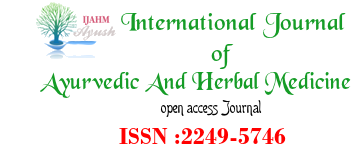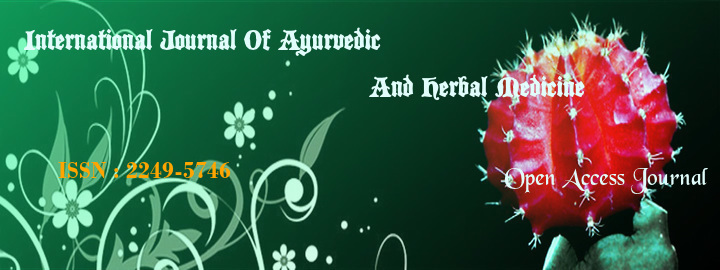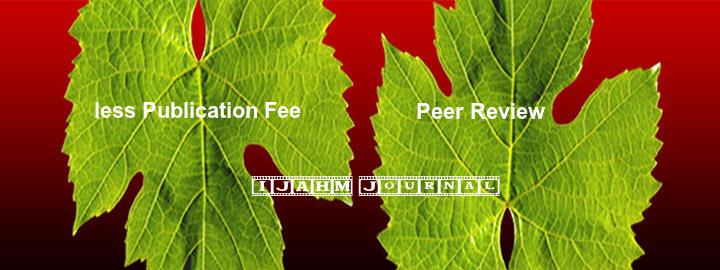


1Dr. Raghunath G. V. , 2Dr. M.S. Veena , 3Dr. Suresh Janadri
1Professor &HOD, Dept. of Dravyaguna, AtreyaAyurvedic Medical College, Hospital & Research Centre, Doddaballapura, Bangalore-561203
2Professor & HOD, Dept. of PG& PhD studies in Dravyaguna, GAMC, Bangalore-560009
3Asst. Professor, Dept. of Pharmacology, Acharya & B. M. Reddy College of Pharmacy, Bangalore
DOI : http://dx.doi.org/10.47191/ijahm/v14i2.01
Abstract:
Panchavalkala the barks of five trees i.e.Nyagrodha (Ficusbenghalensis L.), Udumbara (Ficusracemosa L.), Ashwatha (Ficusreligiosa L.), Plaksha (FicusvirensAiton) and Parisha (Thespesiapopulnea (L.)Sol.ex Correa) are also known as PanchaKsheeriVrikshas in use since Vedic period.The plant samples were collected in SharadRutu( late autumn) from their natural habitat, extracted using ethanol and water and subjected for the phytochemical analysis. It was confirmed that samples contain many biologically active compounds like flavonoids, polyphenols, tannins, alkaloids, glycosides and terpinoids etc.Hence the study was aimed to evaluateAntihyperlipidemic effect (Lekhana Karma) of Panchavalkala Bark extracts individually and in combination (1:1:1:1:1) both in ethanolic and aqueous extracts on serum lipid profile in Cafeteria died (HFD) induced hyperlipidemia in SD rats. The animals were divided in to fifteen groups of six animals each. The normal control group continued to be fed a laboratory pellet chow ad libitum. The cafeteria diet-control group received the cafeteria diet in addition to the normal pellet diet (NPD). The remaining 13 groups were fed with the cafeteria diet and NPD along with standard control Atorvastatin 10mg/kg and the test drug p.o for 30 days. Treatment with the test substance PVK AE and PVK EE at doses of 200mg/kg body weight p.o. controlled and regulated the HFD induced weight gain, glucose and lipids in the blood when compared against high fat diet control (P< 0.05).PVK bark extracts are capable of exhibiting significant antihyperlipidemic activity in HFD induced SD rats by enhancing parameters like antioxidant enzyme, Inhibiting pancreatic lipase enzyme and HMG-Co Enzyme reductase activity as demonstrated in the previous studies. There is significant decrease in body weight, Liver weight, decrease in serum lipids, Lipid ratios and Atherogenic index of plasma as well as regeneration of hepatic structure. Taken together, this study strongly suggests that PVK bark extracts might be an efficient way for treatment of hyperlipidemia.
KEYWORDS: HFD- High fat diet,PVK-Panchavalkala, Atorvastatin, Hyperlipidemia, AE-Aqueous extract, EE- Ethanolic extract, Anti hyperlipidemic
REERENCES:
Ansarullah, Jadeja RN, Thounaojam MC, Patel V, Devkar RV, Ramachandran AV. Antihyperlipidemic potential of a polyherbal preparation on triton WR 1339 (Tyloxapol) induced hyperlipidemia: A comparison with lovastatin. Int J Green Pharm. 2009; 3:119–24. [Google Scholar]
2. R. M. Krauss and Y. A. Kesaniemi, “Cardiovascular disease and hyperlipidaemia,” Current Opinion in Lipidology, vol. 5, no. 4, pp. 249–251, 1994.
3. N. J. Stone, “Lipid management: current diet and drug treatment options,” The American Journal of Medicine, vol. 101, no.
4, supplement 1, pp. 40S–49S, 1996. 4. Y.Lin, S. S. Mousa, N. Elshourbagy, and S. A. Mousa, “Current status and future directions in lipid management: emphasizing low-density lipoproteins, high-density lipoproteins, and triglycerides as targets for therapy,” Vascular Health and Risk Management, vol. 6, no. 1, pp. 73–85, 2010
5. Brown MS, Goldstein JL. Multivalent feedback regulation of HMG CoA reductase, a control mechanism coordinating isoprenoid synthesis and cell growth. J Lipid Res. 1980; 21:505–17.
6. Carbonell T, Freire E. Binding thermodynamics of statins to HMG-CoA reductase. Biochemistry. 2005; 44:11741–8.
7. Corsini A, Maggi FM, Catapano AL. Pharmacology of competitive inhibitors of HMG-CoA reductase. Pharmacol Res. 1995; 31:9–27.
8. Baigent C, Keech A, Kearney PM, Blackwell L, Buck G, Pollicino C, et al. Efficacy and safety of cholesterol-lowering treatment: prospective meta-analysis of data from 90,056 participants in 14 randomized trials of statins. Lancet. 2005; 366(9493):1267–78.
9. Jones PH, Bays HE, Davidson MH, Kelly MT, Buttler SM, Setze CM, et al. Evaluation of a new formulation of fenofibric acid, ABT-335, co-administered with statins: study design and rationale of a phase III clinical programme. Clin Drug Investig. 2008; 28:625–34.
10. Alsheikh-Ali AA, Karas RH. Adverse events with concomitant amiodarone and statin therapy. PrevCardiol. 2005; 8:95–7.
11. Joy TR, Hegele RA. Narrative review: statin-related myopathy. Ann Intern Med. 2009; 150(12):858– 68. 1 Dr. Raghunath G. V.,International Journal of Ayurvedic & Herbal Medicine 14 (2) March-April 2024 (4399-4412) Page 4411
12. A role of Ficus species in the management of diabetes mellitus: A review Journal of Ethnopharmacology, Volume 215, 6 April 2018, Pages 210-232
13. The Ayurveda Pharmacopeia of India Part-I, Vol-V, Ist edition Jan-2006, ISBN:81-901151-6-2.,3-8 printed by NISCAIR, CSIR, Dr. K.S.Krishnan Marg, New Delhi, 110012 and Part-I, Vol-I, ISBN 81- 901151-3-8, 1990, 2001
14. Phytochemical standardization of panchavalkala: An ayurvedic formulation and evaluation of its anticancer activity in cervical cancer cell lines ShamaAphale, Savita Pandita, Prerna Raina, JN Mishra, RuchikaKaul-Ghanekar Pharmacog.Net,Year :2018, Volume :14 , Issue :58, Page :554-560
15. NeerajTandan, Review on Indian Medicinal Plants, Vol-II, Published by ICMR, New Delhi – 2013, ISSN:0972-7957, P.B.No.4911, New Delhi – 110029, India
16. Quality Standards of Indian Medicinal Plants Vol-3, 7, 13, 16, Published by ICMR, V. RamalingaswamiBhawan, Ansari Nagar, P.B.No.4911, New Delhi-110029, India
17. Sarma, D. S. K., &Babu, A. V. S. (2011). Pharmacognostic and phytochemical studies of Thespesiapopulnea Linn. Journal of Chemical and Pharmaceutical Research, 3(4), 237-244.
18. Kumar S, Alagawadi KR, Rao MR. Effect of Argyreiaspeciosa root extract on cafeteria diet-induced obesity in rats. Indian J Pharmacol 2011; 43:163-7. 19. Allian CC, Poon LS, Chan CS, Richmond W, Paul CF. Enzymatic determination of total serum cholesterol. Clin Chem. 1974;
20: 470–5. [PubMed] [Google Scholar] 20. Pari L, Latha M. Effect of Cassia auriculata flowers on blood sugar levels, serum and tissue lipids in streptozotocin diabetic rats. Singapore Med J. 2002; 43: 617–21.
21. Dobiasova M, Frohlich J. The Plasma parameter log (TG/HDL-C) as an atherogenic index: correlation with lipoprotein particle size and esterification rate in apoB-lipoprotein-depleted plasma (FER (HDL)). ClinBiochem. 2001; 34:583-8.
22. Saravana K, Mazumder A, Saravanan VS. Antihyperlipidemic activity of Camellia sinensis leaves in Triton WR-1339 induced albino rats. Pharmacogn Mag. 2008; 4: 60–4. [Google Scholar]
23. SupravaSahoo et al. /Asian Pac J Trop Biomed 2013; 3(11): 871-876 875
24. Anandhi R, Thomas PA, Geraldine P. Evaluation of the antiatherogenic potential of chrysin in Wistar rats. Mol Cell Biochem 2014; 385:103–13.
25. Pandya N, Santani D, Jain S. Antioxidant activity of ezetimibe in hypercholesterolemic rats. Indian J Pharmacol 2006; 38:205–6.
26. Verlecar XN, Jena KB, Chainy GB. Biochemical markers of oxidative stress in Pernaviridis exposed to mercury and temperature. ChemBiol Interact 2007; 167:219–26.
27. Sampey BP, Vanhoose AM, Winfield HM, Freemerman AJ, Muehlbauer MJ, Fueger PT, et al. Cafeteria diet is a robust model of human metabolic syndrome with liver and adipose inflammation: Comparison to high-fat diet. Obesity (Silver Spring) 2011; 19:1109-17.
28. Sclafani A, Springer D. Dietary obesity in adult rats: Similarities to hypothalamic and human obesity syndromes. PhysiolBehav 1976; 17:461-71.
29. Raghunath G.V.,Veena M.S., Lalitha B.R. Phytochemical investigation and in vitro antioxidant activity of Panchavalkala bark extracts IJAPR Feb-2023/Vol-11/Issue-2/ Page no. 1-12
30. Raghunath G.V.,Veena M.S., Lalitha B.R. In Vitro Pancreatic lipase inhibition potential of Panchavalkala Aqueous and Ethanolic extracts JAHM 2022; 10(6): 8-24
31. Visavadiya NP, Narasimhacharya AVRL. Asparagus root regulates cholesterol metabolism and improves antioxidant status in hypercholesteremic rats. Advance Access Publication. 2009; 6:219–26. 1 Dr. Raghunath G. V.,International Journal of Ayurvedic & Herbal Medicine 14 (2) March-April 2024 (4399-4412) Page 4412
32. Da Silva VB, Taft CA, Silva CHTP. Use of virtual screening, flexible docking, and molecular interaction fields to design novel HMG-CoA reductase inhibitors for the treatment of hypercholesterolemia. J PhysChem A. 2008; 112: 2007–11.
33. Bioactivity guided fractionation and hypolipidemic property of a novel HMG-CoA reductase inhibitor from FicusvirensAit Danish Iqbal1 , M Salman Khan1*, MohdSajid Khan1 , Saheem Ahmad1 , MdSarfaraj Hussain2 and Mohd Ali3 Iqbal et al. Lipids in Health and Disease (2015) 14:15 DOI 10.1186/s12944-015-0013-6
34. Khanna AK, Rizvi F, Chander R. Lipid lowering activity of Phyllanthusniruri in hyperlipidemic rats. J Ethnopharmacol 2002; 82:19–22.
35. Fungwe TV, Cagen LM, Cook GA, Wilcox HG, Heimberg M. Dietary cholesterol stimulates hepatic biosynthesis of triglyceride and reduces oxidation of fatty acids in the rat. J Lipid Res 1993;34:933-41
36. Buhman KK, Chen HC, Farese RV Jr. The enzymes of neutral lipid synthesis. J BiolChe 2001; 276: 40369-72.
37. Horton JD, Goldstein JL, Brown MS. SREBPs: Activators of the complete program of cholesterol and fatty acid synthesis in the liver. J Clin Invest 2002; 109:1125-31.
38. Altmann SW, Davis HR, Zhu LJ. Niemann Pick C1 like 1 protein is critical for intestinal cholesterol absorption. Science 2004; 303:1201-4.
39. Bioactivity guided fractionation and hypolipidemic property of a novel HMG-CoA reductase inhibitor from FicusvirensAit Iqbal et al. Lipids in Health and Disease (2015) 14:15 DOI 10.1186/s12944-015- 0013-6
40. Assmann G, Nofer JR. Atheroprotective effects of high-density lipoproteins. Annu Rev Med 2003; 54:321-41.
41. Vergès B. Pathophysiology of diabetic dyslipidaemia: where are we? Diabetologia. 2015; 58:886–899.
42. Journal of Cardiovascular Pharmacology: Volume 16 - Issue - p S1-S7, Abbate, Samuel L.; Brunzell, John D. Pathophysiology of Hyperlipidemia in Diabetes Mellitus
43. Journal of Ethnopharmacology, Volume 215, 6 April 2018, Pages 210-232, A role of Ficus species in the management of diabetes mellitus: A review
44. Shahidi F, Janitha PK, Wanasundara PD. Phenolic antioxidants. Ctit Rev Food SciNutr. 1992; 202:307
45. Gotto AM, Assmann G, Carmena R, et al. The ILIB lipid handbook for clinical practice: blood lipids and coronary heart disease. 2nd ed. New York, NY: International Lipid Information Bureau; 2000. p. 52.p. 53.p. 201. [Google Scholar]
46. Genest J, Frohlich J, Fodor G, McPherson R the Working Group on Hypercholesterolemia and Other Dyslipidemias. Recommendations for the management of dyslipidemia and the prevention of cardiovascular disease:
47. www.ncbi.nlm.nih.gov/pmc/articles/PMC6079547/ Myat Su Bo, WhyeLianCheah, SoeLwin, Tin Moe Nwe, Than Than Win, Myint Aung; Publish Year: 2018 48. Vasc Health Risk Manag. 2009; 5: 757–765. Published online 2009 Sep 18. PMCID: PMC2747394 PMID: 19774217
index






















